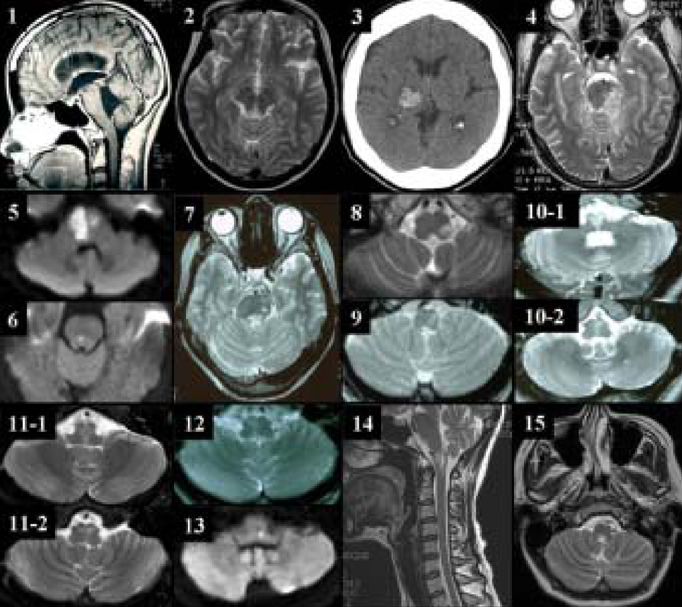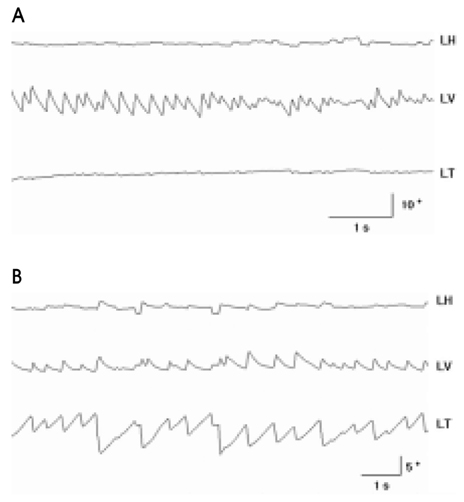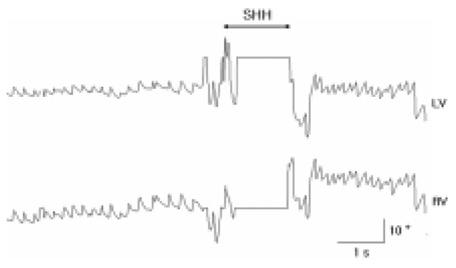J Clin Neurol.
2006 Mar;2(1):58-65. 10.3988/jcn.2006.2.1.58.
Upbeat Nystagmus: Clinicoanatomical Correlations in 15 Patients
- Affiliations
-
- 1Department of Neurology, College of Medicine, Seoul National University, Seongnam, Korea. jisookim@snu.ac.kr
- 2Department of Neurology, College of Medicine, The Catholic University of Korea, Seoul, Korea.
- 3Department of Neurology, College of Medicine, Eulji University, Seoul, Korea.
- KMID: 2287704
- DOI: http://doi.org/10.3988/jcn.2006.2.1.58
Abstract
- BACKGROUND AND PURPOSE
The mechanism of upbeat nystagmus is unknown and clinicoanatomical correlative studies in series of patients with upbeat nystagmus are limited.
METHODS
Fifteen patients with upbeat nystagmus received full neuro-ophthalmological evaluation by the senior author. Nystagmus was observed using video Frenzel goggles and recorded with video-oculography. Brain lesions were documented with MRI.
RESULTS
Lesions responsible for nystagmus were found throughout the brainstem, mainly in the paramedian area: in the medulla (n=8), pons (n=3), pons and midbrain with or without cerebellar lesions (n=3), and midbrain and thalamus (n=1). Underlying diseases comprised cerebral infarction (n=10), multiple sclerosis (n=2), cerebral hemorrhage (n=1), Wernicke encephalopathy (n=1), and hydrocephalus (n=1). Upbeat nystagmus was mostly transient and showed occasional evolution during the acute phase. In one patient with a bilateral medial medullary infarction, the upbeat nystagmus changed into a hemiseesaw pattern with near complete resolution of the unilateral lesion. Gaze and positional changes usually affected both the intensity and direction of the nystagmus. A patient with a cervicomedullary lesion showed a reversal of upbeat into downbeat nystagmus by straight-head hanging and leftward head turning while in the supine position. Gaze-evoked nystagmus (n=7), ocular tilt reaction (n=7), and internuclear ophthalmoplegia (n=4) were also commonly associated with upbeat nystagmus.
CONCLUSIONS
In view of the responsible lesions and associated neuro-ophthalmological findings, upbeat nystagmus may be ascribed to damage to the pathways mediating the upward vestibulo-ocular reflex or the neural integrators involved in vertical gaze holding.
MeSH Terms
Figure
Cited by 2 articles
-
Primary Position Upbeat Nystagmus during an Acute Attack of Multiple Sclerosis
Jee-Ae Kim, In-Hye Jeong, Young-Min Lim, Kwang-Kuk Kim
J Clin Neurol. 2014;10(1):37-41. doi: 10.3988/jcn.2014.10.1.37.A Case of Rotational Vertebral Artery Syndrome after Vertebral Artery Dissection
Song Jae Lee, Ha Young Byun, Seung Hwan Lee, Jae Ho Chung
Korean J Otorhinolaryngol-Head Neck Surg. 2020;63(5):228-232. doi: 10.3342/kjorl-hns.2019.00633.
Reference
-
1. Leigh RJ, Zee DS. The neurology of eye movements. 1999. 3rd edn. New York: Oxford University Press.2. Kumar A, Patni AH, Charbel F. The Chiari I malformation and the neurotologist. Otol Neurotol. 2002. 23:727–735.
Article3. Zingler VC, Strupp M, Jahn K, Glaser M, Herberger S, Kretzschmar HA, et al. Upbeat nystagmus as the initial clinical sign of Creutzfeldt-Jakob disease. Ann Neurol. 2005. 57:607–608.
Article4. Jay WM, Marcus RW, Jay MS. Primary position upbeat nystagmus with organophosphate poisoning. J Pediatr Ophthalmol Strabismus. 1982. 19:318–319.
Article5. Sibony PA, Evinger C, Manning KA. Tobacco-induced primary-position upbeat nystagmus. Ann Neurol. 1987. 21:53–58.6. Stahl JS, Averbuch-Heller L, Leigh RJ. Acquired nystagmus. Arch Ophthalmol. 2000. 118:544–549.
Article7. Baloh RW, Yee RD. Spontaneous vertical nystagmus. Rev Neurol (Paris). 1989. 145:527–532.8. Pierrot-Deseilligny C, Milea D. Vertical nystagmus: clinical facts and hypotheses. Brain. 2005. 128:1237–1246.
Article9. Hirose G, Kawada J, Tsukada K, Yoshioka A, Sharpe JA. Upbeat nystagmus: clinicopathological and pathophysiological considerations. J Neurol Sci. 1991. 105:159–167.
Article10. Choi KD, Jung DS, Park KP, Jo JW, Kim JS. Bowtie and upbeat nystagmus evolving into hemi-seesaw nystagmus in medial medullary infarction: possible anatomic mechanisms. Neurology. 2004. 62:663–665.
Article11. Kim JS, Han DH, Moon SY, Park SH. Convergence-related nystagmus in a patient with hydrocephalus from shunt malfunction. J Korean Neurol Assoc. 2004. 22:392–395.12. Kim JS, Choi KD, Oh SY, Park SH, Han MK, Yoon BW. Medial medullary infarction: abnormal ocular motor findings. Neurology. 2005. 65:1294–1298.
Article13. Cox TA, Corbett JJ, Thompson HS, Lennarson L. Upbeat nystagmus changing to downbeat nystagmus with convergence. Neurology. 1981. 31:891–892.
Article14. Mizuno M, Kudo Y, Yamane M. Upbeat nystagmus influenced by posture: report of two cases. Auris Nasus Larynx. 1990. 16:215–221.
Article15. Sakuma A, Kato I, Ogino S, Okada T, Takeyama I. Primary position upbeat nystagmus with special reference to alteration to downbeat nystagmus. Acta Otolaryngol Suppl. 1996. 522:43–46.16. Halmagyi GM, Leigh RJ. Upbeat about downbeat nystagmus. Neurology. 2004. 63:606–607.
Article17. Halmagyi GM, Rudge P, Gresty MA, Sanders MD. Downbeating nystagmus. A review of 62 cases. Arch Neurol. 1983. 40:777–784.18. Marti S, Palla A, Straumann D. Gravity dependence of ocular drift in patients with cerebellar downbeat nystagmus. Ann Neurol. 2002. 52:712–721.
Article19. Leigh RJ, Das VE, Seidman SH. A neurobiological approach to acquired nystagmus. Ann N Y Acad Sci. 2002. 956:380–390.
Article20. Goltz HC, Irving EL, Steinbach MJ, Eizenman M. Vertical eye position control in darkness: orbital position and body orientation interact to modulate drift velocity. Vision Res. 1997. 37:789–798.
Article21. Fisher A, Gresty M, Chambers B, Rudge P. Primary position upbeating nystagmus. A variety of central positional nystagmus. Brain. 1983. 106:949–964.22. Janssen JC, Larner AJ, Morris H, Bronstein AM, Farmer SF. Upbeat nystagmus: clinicoanatomical correlation. J Neurol Neurosurg Psychiatry. 1998. 65:380–381.
Article23. Marcus JT, Bles W, Van Holten CR. Influence of gravitoinertial force on vestibular nystagmus in man observed in a centrifuge. Adv Space Res. 1989. 9:213–222.
Article24. Kastrup O, Maschke M, Keidel M, Diener HC. Presumed pharmacologically induced change from upbeat to downbeat nystagmus in a patient with Wernicke's encephalopathy. Clin Neurol Neurosurg. 2004. 107:70–72.
Article25. Keane JR, Itabashi HH. Upbeat nystagmus: clinicopathologic study of two patients. Neurology. 1987. 37:491–494.
Article26. Brandt T, Dieterich M. Vestibular syndromes in the roll plane: topographic diagnosis from brainstem to cortex. Ann Neurol. 1994. 36:337–347.
Article27. Ranalli PJ, Sharpe JA. Upbeat nystagmus and the ventral tegmental pathway of the upward vestibulo-ocular reflex. Neurology. 1988. 38:1329–1330.
Article28. Kattah JC, Kolsky MP, Guy J, O' Doherty D. Primary position vertical nystagmus and cerebellar ataxia. Arch Neurol. 1983. 40:310–314.
Article29. Nakada T, Remler MP. Primary position upbeat nystagmus. Another central vestibular nystagmus? J Clin Neuroophthalmol. 1981. 1:185–189.30. Oh K, Chang JH, Park KW, Lee DH, Choi KD, Kim JS. Jerky seesaw nystagmus in isolated internuclear ophthalmoplegia from focal pontine lesion. Neurology. 2005. 64:1313–1314.
Article31. Carpenter MB, Cowie RJ. Connections and oculomotor projections of the superior vestibular nucleus and cell group 'y'. Brain Res. 1985. 336:265–287.
Article32. Sato Y, Kawasaki T. Target neurons of floccular caudal zone inhibition in Y-group nucleus of vestibular nuclear complex. J Neurophysiol. 1987. 57:460–480.
Article33. Sato Y, Kawasaki T, Mizukoshi K. Eye movement control by Purkinje cell/climbing fiber zones of cerebellar flocculus in cat. Acta Otolaryngol Suppl. 1991. 481:237–241.
Article34. Uchino Y, Sasaki M, Isu N, Hirai N, Imagawa M, Endo K. Second-order vestibular neuron morphology of the extra-MLF anterior canal pathway in the cat. Exp Brain Res. 1994. 97:387–396.
Article35. Gilman N, Baloh RW, Tomiyasu U. Primary position upbeat nystagmus. A clinicopathologic study. Neurology. 1977. 27:294–298.
Article36. Kato I, Nakamura T, Watanabe J, Harada K, Aoyagi M, Katagiri T. Primary position upbeat nystagmus. Localizing value. Arch Neurol. 1985. 42:819–821.37. Munro NA, Gaymard B, Rivaud S, Majdalani A, Pierrot-Deseilligny C. Upbeat nystagmus in a patient with a small medullary infarct. J Neurol Neurosurg Psychiatry. 1993. 56:1126–1128.
Article38. Hirose G, Ogasawara T, Shirakawa T, Kawada J, Kataoka S, Yoshioka A, et al. Primary position upbeat nystagmus due to unilateral medial medullary infarction. Ann Neurol. 1998. 43:403–406.
Article39. Ohkoshi N, Komatsu Y, Mizusawa H, Kanazawa I. Primary position upbeat nystagmus increased on downward gaze: clinicopathologic study of a patient with multiple sclerosis. Neurology. 1998. 50:551–553.
Article40. Tilikete C, Hermier M, Pelisson D, Vighetto A. Saccadic lateropulsion and upbeat nystagmus: disorders of caudal medulla. Ann Neurol. 2002. 52:658–662.
Article41. Tyler KL, Sandberg E, Baum KF. Medical medullary syndrome and meningovascular syphilis: a case report in an HIV-infected man and a review of the literature. Neurology. 1994. 44:2231–2235.
Article42. Minagar A, Sheremata WA, Tusa RJ. Perverted head-shaking nystagmus: a possible mechanism. Neurology. 2001. 57:887–889.
Article43. McCrea RA, Strassman A, Highstein SM. Anatomical and physiological characteristics of vestibular neurons mediating the vertical vestibulo-ocular reflexes of the squirrel monkey. J Comp Neurol. 1987. 264:571–594.
Article44. Langer T, Fuchs AF, Scudder CA, Chubb MC. Afferents to the flocculus of the cerebellum in the rhesus macaque as revealed by retrograde transport of horseradish peroxidase. J Comp Neurol. 1985. 235:1–25.
Article45. Büttner-Ennever JA, Büttner U. Büttner-Ennever JA, editor. The reticular formation. Neuroanatomy of the oculomotor system. 1988. Amsterdam: Elsevier;119–176.46. Büttner-Ennever JA, Horn AK. Pathways from cell groups of the paramedian tracts to the floccular region. Ann N Y Acad Sci. 1996. 781:532–540.
Article47. Büttner-Ennever JA, Horn AKE, Schmidtke K. Cell groups of the medial longitudinal fasciculus and paramedian tracts. Rev Neurol (Paris). 1989. 145:533–539.48. Halmagyi GM, Aw ST, Dehaene I, Curthoys IS, Todd MJ. Jerk-waveform see-saw nystagmus due to unilateral mesodiencephalic lesion. Brain. 1994. 117:789–803.
Article
- Full Text Links
- Actions
-
Cited
- CITED
-
- Close
- Share
- Similar articles
-
- Transient Upbeat Nystagmus Due to Unilateral Pontine Infarction
- Upbeat Nystagmus in Association with Wall-Eyed Bilateral Internuclear Ophthalmoplegia
- Primary Position Upbeat Nystagmus during an Acute Attack of Multiple Sclerosis
- Mechanism of Downbeat Nystagmus While Normal Subjects HaveHead Upside-down Position in Darkness
- Dissociated Vertical-Torsional Nystagmus in Vestibular Nucleus Lesion




